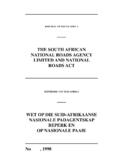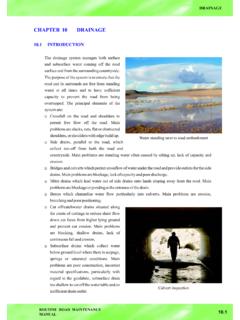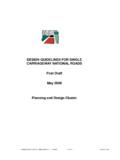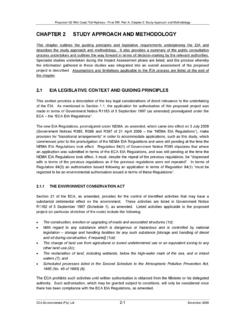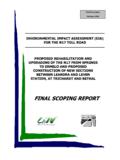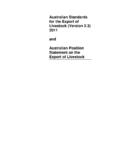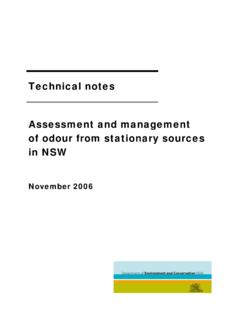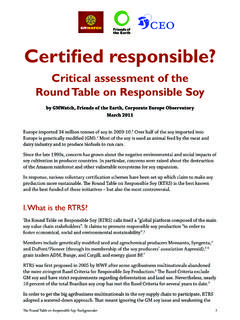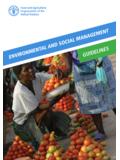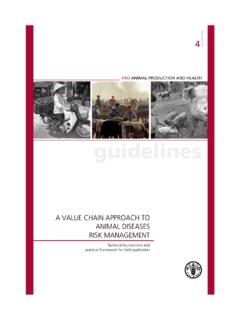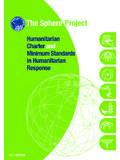Transcription of DOCS NRA-#26741-v2-POLICY IN RESPECT OF …
1 POLICY IN RESPECT OF road planning AND design SOUTH AFRICAN NATIONAL ROADS AGENCY LIMITED JANUARY 2003 POLICY FOR road planning AND GEOMETRIC design TABLE OF CONTENTS 1. GENERAL .. 1 1 Philosophy .. 1 Application of Procedures and Guidelines .. 2 2. PROJECT DEVELOPMENT .. 3 General .. 3 3 3. ENVIRONMENTAL 3 Introduction .. 3 Aims of EIA 4 4. ACCESS 5 General 5 Frontage roads .. 6 Access via the surrounding road network (intersections and interchanges).. 6 Direct Access Roadside Service and Rest Areas ..6 Objectives .. 6 Process .. 6 Location .. 7 7 7 Access from Local and Provincial Roads .. 7 Other Requirements .. 7 Costs .. 8 Informal Trading Areas .. 8 5. BUILDING RESTRICTION AREAS AND UTILITY SERVICES .. 8 8 Determination of Restrictions .. 9 Building restriction line and Applications for Subdivision .. 9 Revised land use .. 9 Utility Services .. 9 6. ROADSIDE ADVERTISING AND TOURISM SIGNS.
2 9 Management of roadside advertising .. 9 Tourism signs .. 10 7. road LIGHTING .. 10 General .. 10 8. PEDESTRIAN FACILITIES,CYCLE PATHS AND LIVESTOCK 11 General .. 11 Pedestrian Facilities .. 11 Public 11 road Shoulders .. 11 Sidewalks and cycling Pedestrian and Cyclist Grade 12 Facilities for Disabled People .. 12 Livestock 13 General .. 13 Policy January 2003 1 SOUTH AFRICAN NATIONAL ROADS AGENCY LIMITED POLICY FOR road planning AND GEOMETRIC design Approved by the Board of Directors in January 2003 1. GENERAL Relevance This Policy governs the Procedures for road planning and Geometric design for proclaimed National Roads. The content of the Procedures and of the Guidelines should therefore be interpreted against the background of this Policy. The Procedures for road planning and Geometric design are intended to guide and inform Applicants applying for approvals, permits or permissions required of the SANRAL, as well as provide guidance to designers working on SANRAL projects.
3 The SANRAL Geometric design Guidelines are intended to provide planners and designers of SANRAL road schemes and projects, as well as associated road planning impacting on National Roads, with optimal guidelines to enable them to provide the SANRAL with fit for purpose, safe, cost effective and operationally effective designs. This document is to be read and used in conjunction with the SANRAL Agreement for Consulting Engineering Services, the Procedures for road planning and Geometric design , the Geometric design Guidelines and the Southern African Development Community road Traffic Signs Manual. Philosophy SANRAL, as the custodian of the National road network, has a duty of care to ensure that the road planning and geometric design process enhances the safety and mobility of road users in balance with other values. In the development of road projects, social, economic, safety and environmental effects should be ranked alongside technical issues so that the final result is in the best overall public interest.
4 Attention should be paid to the: Need for safe and efficient road travel; Balanced attainment of community goals and objectives, and hence, integrated development planning objectives; Needs of low mobility and disadvantaged groups; Costs of eliminating, mitigating or minimizing adverse effects on natural resources, environmental values, public services, aesthetic values, and community and individual integrity; Realistic use of financial resources; and Cost, ease and safety of maintaining the road infrastructure. Deleted: Policy January 2003 2 This requires that a facility be viewed from the perspectives of the user, the nearby community and the managers of the network. For the road user, predictable and efficient travel, and in particular, safety, are paramount. On other hand, a roadside community is often concerned about aesthetic, social, financial and economic impacts as well as traffic flow through the community.
5 From the road authorities perspective, the design of any facility should be affordable in the prevailing financial circumstances, and provide for safe travel. Therefore, individual projects must be designed to balance the system benefits with national and community goals, plans and values, and must be sustainable in the long term. To achieve these sometimes conflicting objectives, emphasis should be placed on flexibility when using design guidelines and on innovative, site specific design . Designs should also allow different transportation modes to work together effectively. Application of Procedures and Guidelines The policies in this document, the Procedures for road planning and Geometric design and the Geometric design Guidelines both inform the designer of the manner in which the SANRAL expects its work to be undertaken, and guide the designer towards sound judgment in applying standards, consistent with the philosophy described above.
6 At the same time, other important Guidelines and Legislation should not be forgotten. Examples of these are the South African road Traffic Safety Manual, and the Environmental Legislation. The design standards used for any project should, where possible, equal or exceed the minimum given in the guidelines, taking into account all costs, traffic volumes, safety benefits, land requirements and socio-economic and environmental impacts. The philosophy, however, provides for the use of lower standards when they best satisfy a given situation without compromising safety. Because design standards have evolved over decades, many existing roads may not conform to modern standards. It is not intended that modern standards be applied retroactively; neither is this always warranted or economical. However, when warranted, upgrading of existing roadway elements such as guardrails, lighting, super-elevation and re-alignment should be planned, either as independent projects or as part of larger projects.
7 The elimination of known traffic hazards should form part of projects. Policy January 2003 3 2. PROJECT DEVELOPMENT General The development of a particular road project should, where applicable, be sensitive to and, inter alia, consist of; community consultation and participation; planning transparency; environmental concerns; safety concerns; economic and financial viability; operational consistency within a particular route; system integration; network accessibility; land use planning ; scheme projections; and forward planning . In the preparation of designs, innovation and creativity are encouraged. Nevertheless, general uniformity in road operations is important and the drawings should embrace all necessary information, taking into account the diverse requirements of the various elements of design (geometric, structural, geotechnical and pavement) as they effect construction, and the potential of construction activities to provide much needed work to local communities.
8 Phases For convenience, project development is split into four phases: Project proposal and assessment; Route location, where applicable; Basic planning , where applicable; and design These phases are addressed separately in the terms of reference for consulting engineers, and should all form part of an integrated and holistic project development process. 3. ENVIRONMENTAL POLICY Introduction Environmental management is an integral component of road infrastructure development and road Policy January 2003 4 management. A sustainable road network that meets the requirements of both people and the environment requires innovation to face the challenges. There needs to be a drive to find a balance between the interests of the road user and the roads authorities on the one hand, and environmental interests, including socio-economic interests, on the other. The planning and geometric design of roads should be undertaken with the environment being considered with each step of the process taken.
9 Aims of EIA Process The Environment Conservation Act, 1989 (Act No. 73 of 1989) regulates the control of activities which may have a detrimental effect on the environment. These are listed in Government Notice R1182 of 5 September 1997. One of the listed activities is the building or upgrading of roads and, generally, no work may commence until written authority is obtained. Approval, which may be granted conditionally, will only be granted once the regulations are complied with. Government Notice R1183 sets out the procedures to be followed and documentation required to be completed when undertaking an Environmental Impact Assessment (EIA). Certain maintenance works are exempted from these requirements, and designers are advised to obtain clarity from SANRAL prior to commencing with their work The main aims of the environmental assessment process, in the context of a proposed road scheme, are: To ensure full consideration by the SANRAL and the relevant environmental authorities of the potential environmental impacts associated with the road project; To ensure that the SANRAL and the relevant environmental authorities are able to make informed decisions when considering environmental impacts; To assess the potential environmental impacts in the planning of the road in a way that enables the importance of the potential impacts and the proposed mitigation of the impacts to be evaluated.
10 And To obtain contributions of Interested and/or Affected Parties (including relevant authorities and the public) and ensure that all issues, concerns and queries raised are fully documented and carried forward in the EIA process. The EIA process must ensure that environmental consequences are considered at all stages of the project, as this will allow the SANRAL and its service providers to design a road based on sound environmental principles. Assessment and design should be an integrated process. It should be remembered that the term environment in the context of an EIA refers to both biophysical and socio-economic issues. Policy January 2003 5 4. ACCESS CONTROL General policy Control of access to National Roads is achieved by restricting rights of access to the roadway from roadside developments, properties and the surrounding road network. In general, access to National Roads will only be allowed for; The complementary and surrounding public road network, via intersections and where freeways are concerned, via interchanges; Roadside service and rest areas catering for light and/or heavy motor vehicles; Roadside trading enterprises (in limited cases); and Public transport stopping places.
